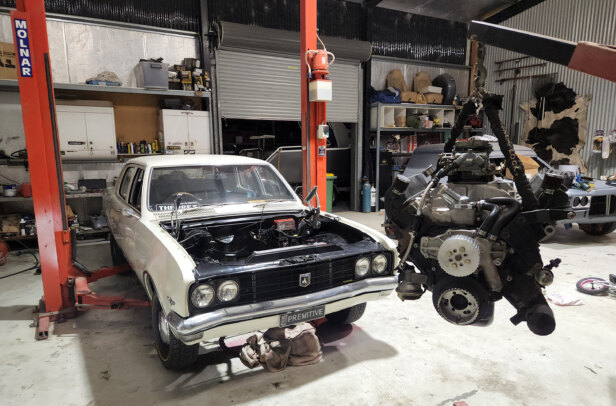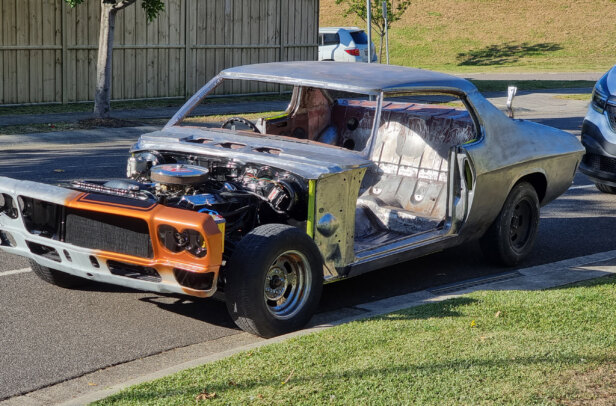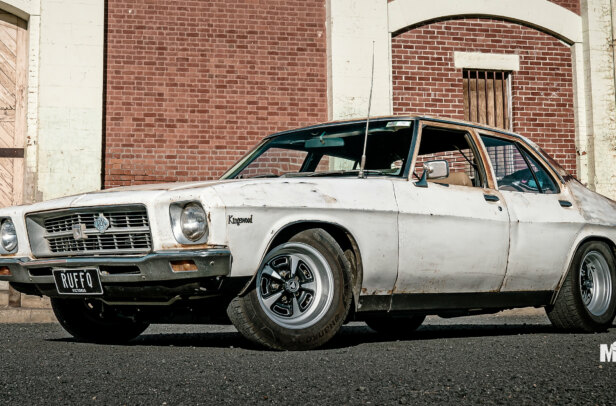Getting stuck into a project-car build at home without the right equipment is a sure and quick path to frustration. But while we can dream of having one of those bright, clean, fully stocked workshops you see on TV shows, plenty of people have built righteous rides with far humbler set-ups. Here’s how you tool up for success.
RESEARCH & DEVELOP
Sheds in residential areas can have some crucial limitations around the type of equipment you can bring in, so do some research on what’s allowable. Before you bash a hoist in, you’ll need to scan the concrete slab to make sure it’s the correct density (MPA rating) to hold one up, and not a tensioned slab with cables running through it.
Another trap for young players is power. If your shed isn’t wired for three-phase power, you may be shocked at the cost of upgrading to a workshop-grade electrical supply. The good news is there are still plenty of excellent-quality hoists, welders and compressors that can run on 15A outlets.
Finally, before you go moving large, heavy tooling and cars into your shed, we highly recommend painting the floor in a proper workshop epoxy to cut down on concrete dust, make it easier to clean up fluids, and reflect light better. This will take a couple of days to do, as it often requires grinding and acid-etching the floor before painting.
Paying a professional to do this is a capital idea. It can also be a great idea to line the walls with white coolroom panelling to help brighten the workspace and provide some insulation against the heat and cold. Anything that can make your shed a nicer place to be will help you enjoy the hours you put in there.
THE BARE BONES
Before you go spending the US defence budget on brand-name roll-cab toolboxes the size of a Peterbilt, make sure your garage has the basic equipment outlined here.
Some sheds will come with built-in workbenches, and you may already have a jack and stands, but it’s always good to have more!
AIR FORCE
Running big air compressors (and power tools) in a residential area late at night while you thrash to meet a deadline can prompt unwelcome visits from your local council. Fortunately, there are compressors available these days from companies like Chicago Pneumatic that’ll run very quietly using multiple motors and still offer 100 litres of air storage.
Spending up to $1500 on a large, well-made, quiet air compressor is a solid idea for anyone tackling a project that includes fabrication and paintwork. A compressor with a large amount of air storage will let you run tools like die grinders, palm sanders, small paint guns, and air blowers (which make cleaning up a literal breeze).
Getting a retractable air hose reel and mounting it solidly is an absolute must if you’re going to run air tools; coiling up plastic hose is a job nobody wants to do and it makes your shed extra messy. Having a couple of stout water traps is another must-have, as you don’t want water ruining your grinder or paintwork.
HANDY EXTRAS
It’s easy to get sidetracked drooling over hoists, lathes, sheet-metal brakes and all those Hollywood tools. However, some of the handiest additions to garages are usually smaller, cheaper pieces of kit.
My father loves to keep sheets of thick cardboard around his garage; they can be nice to lie on, and are also handy for protecting paintjobs and glass from grinding sparks. Similarly, grabbing large moving blankets to throw over cars while you’re spitting sparks and metal filings all over the place will prevent unwanted scarring.
THE BIG TICKETS
Any shed used to build cars will need vital infrastructure like an engine crane, a parts washer and a welder. These pieces of equipment will make it possible to fabricate, swap engines, clean parts and more.
HANDY TIPS:
1. You won’t get far with your project car if you don’t have at least four pyramid-base chassis stands. Having a second jack and a couple of spare stands will help with installing large, heavy parts, or for holding things like diffs off the floor when you’re working on them.
2. A sturdy, well-made workbench that’s around hip height is a crucial addition to any shed. While you could build an engine on the floor, the work you do will be immeasurably better if you’ve got a solid workbench you can be comfortable at. A bench with a metal top will be handiest for working on filthy old engines and transmissions.
3. You’re going to struggle to get even basic jobs done without a good-quality trolley jack. They come in handy when working on suspensions, installing engines and transmissions, removing K-frames and more. In fact, you might be surprised at how often you’ll use the jack, so spend decent money on it.
4. Spend decent money on a quality vice so you can hold your jobs firmly. This is also a safety issue; drilling into your hand sucks and will affect the quality of the high fives you’ll give when your car finally roars into life. A swivelling vice will mean you’ll never have to fight the orientation.
5. You should feel as comfortable as possible while working, so create the best environment for yourself by having things like a sound system for tunes, a fridge for refreshments, and a fan (for hot weather) or heater (for cold). These won’t make your car go, but they will make it far easier to spend countless hours in this place making your hands bleed and overcoming frustrations that would make a regular person rage-quit.
6. When it comes to glueing metal together, a MIG welder (with Argoshield gas) is probably the best bang-for-buck solution for a starter home shed. For around $1000, you can set yourself up with a decent learner’s MIG unit, bottle of gas, welding helmet, gloves, bag of spare tips, and a couple of flap discs for your grinder (until you get good).
7. Unless you’re starting with a brand new car, any project you dive into will need plenty of cleaning, so budgeting for a parts washer up front can save bulk lower back pain down the track. It’s also vital for forensic analysis should you need to remove broken parts and clean them up to work out why you drove over your own crankshaft.
8. Every shed should also have an engine crane, like this bad boy from Hare & Forbes. Ideally it should be a fold-up one, as it will spend plenty of time tucked in the corner not being used. However, when you need it, it’ll make pulling an engine or moving a complete diff an easy task. You can also use it to drop whole drivetrains out of cars or to lift bodyshells off chassis.
9. If you’re going to be fabricating parts, buying a good-quality bench grinder should be near the top of your list of purchases. A pedestal-mounted grinder will improve the quality of your fabrication, and can also clean up grotty bits if used with wire or buffing wheels. With a linishing belt, bench grinders are perfect for preparing parts for welding, too.
10. Masking plastic isn’t just great for stopping overspray getting everywhere; it can also be used to stop your project’s interior filling up with grinding dust. Good-quality masking plastic will come with tape already fitted to the top edge, and you simply pull down as much material as you need to cover the job. Cheap and simple, but it can prevent having to spend days vacuuming workshop dust out of your car’s interior!
11. Having a trolley or portable workbench to carry all your oil-leaking, dirt-encrusted pieces of mechanical sadness will save you grotting up your shop floor. These can be wheeled to a spot where you can get into cleaning them up, far away from nice paintjobs or clean guests.
12. A pressure washer is great for cleaning the driveway, but it also makes short work of washing down project cars, dirty parts, and also your daily driver. If you don’t need to clean the undercarriage of your car with high-pressure water, are you really driving it hard enough?
13. You’ll be using a lot of sprays with a project, and a lockable metal cabinet is a great place for them, as it will keep them organised and out of the hands of smaller family members. We’re talking penetrating oils to loosen rusted fasteners, spray paints, brake or carby cleaning sprays, contact cleaner for electrics, and specialty items like bearing and rubber grease, freeze-sprays for seized fasteners, Silastics and glues, and maybe an adults-only calendar.
14. If you’re going to build a car, you’ll need storage space. Most punters agree that you’ll need three times the car’s floor space in storage space if you’re going to blow it apart. This means you’ll require sturdy metal shelving for storing parts away from grinding sparks and overspray.
15. Cleaning up is going to be a large part of project-car life. From removing schmutz from the car to wiping yourself down as you roll back into the house late at night, you’ll go through countless rags. So buying a really big bag of rags is a worthy purchase – as you will no doubt discover the first time you flip over that engine on the stand and discover you forgot to drain the oil.




Comments